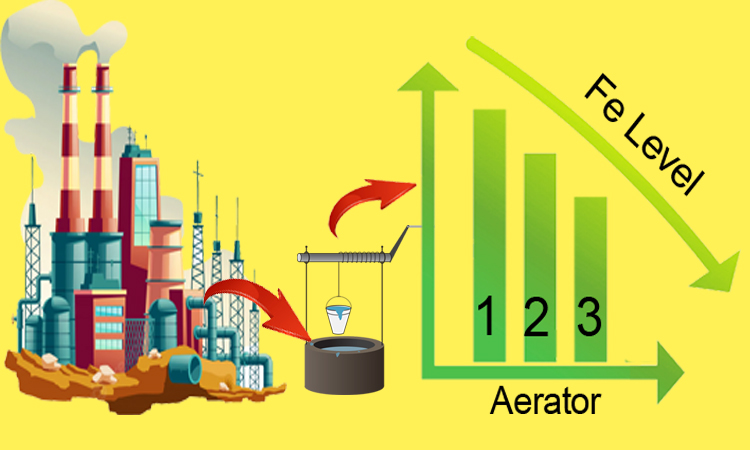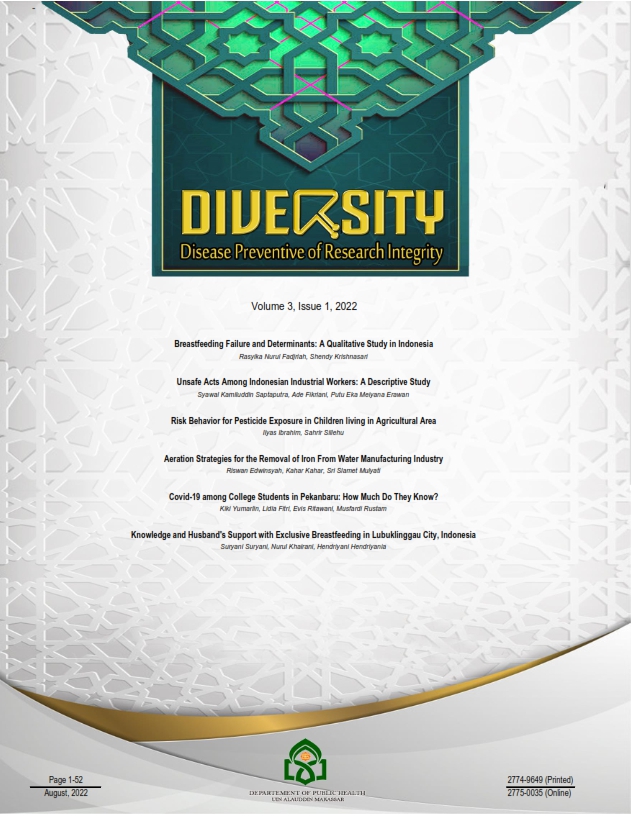Aeration Strategies for the Removal of Iron From Water Manufacturing Industry
Abstract
Clean water used for daily needs in the industry must meet health requirements and be safe to use, but artesian well water often contains various dangerous metals, one of which is iron. This study aimed to determine the effect of various variations in the length of aeration contact time on the reduction of iron content in water. In this study, the aeration process of water with various variations in the number of aerators was carried out to reduce the iron content. This type of research was experimental research with a pre and post-test design. The population and sample in this study were partially artesian well water in the shoe industry office. The sampling technique in this study used grab sampling. The results showed the greatest decrease in iron content was in 3 aerators with an initial iron content of 1.18 mg/l after treatment to 0.15 mg/l. The results showed that reducing iron content in clean water with variations in the number of aerators reduced Fe levels. It is recommended to the shoe industry to reduce the iron content of clean water by using an aeration process using an aerator with a capacity of 5 L/second. This study found that using aerators can be effectively used as an economical method in reducing iron content in the industrial and community environment.

Downloads
References
Al Kholif, M., Sugito, S., Pungut, P., & Sutrisno, J. (2020). Kombinasi Tray Aerator Dan Filtrasi Untuk Menurunkan Kadar Besi (Fe) Dan Mangan (Mn) Pada Air Sumur. Ecotrophic, 14(1), 28-36. https://doi.org/10.24843/EJES.2020.v14.i01.p03
Ardhala, A. D., Santoso, E. B., & Sulistyarso, H. (2016). Influence factors on the development of creative industry as tourism destination (Case Study: Footwear Village in Mojokerto City). Procedia-Social and Behavioral Sciences, 227, 671-679. https://doi.org/10.1016/j.sbspro.2016.06.131
Artidarma, B. S., Fitria, L., & Sutrisno, H. (2021). Pengolahan Air Bersih dengan Saringan Pasir Lambat Menggunakan Pasir Pantai dan Pasir Kuarsa. Jurnal Teknologi Lingkungan Lahan Basah, 9(2), 071-081. http://dx.doi.org/10.26418/jtllb.v9i2.47639
Budiman, B., Hamidah, H., & Hasria, H. (2018). Limbah kulit pisang kepok (Musa acuminate) sebagai biofilter zat besi (Fe) dan zat kapur (CaCO3). Promotif: Jurnal Kesehatan Masyarakat, 8(2), 152-158. http://dx.doi.org/10.26630/jk.v5i2.48
Carvalho Filho, J., Nunhes, T. V., & Oliveira, O. J. (2019). Guidelines for cleaner production implementation and management in the plastic footwear industry. Journal of Cleaner Production, 232, 822-838. https://doi.org/10.1016/j.jclepro.2019.05.343
Cheah, L., Ciceri, N. D., Olivetti, E., Matsumura, S., Forterre, D., Roth, R., & Kirchain, R. (2013). Manufacturing-focused emissions reductions in footwear production. Journal of cleaner production, 44, 18-29. https://doi.org/10.1016/j.jclepro.2012.11.037
Christiani, A., Kristina, H. J., & Rahayu, P. C. (2017). Pengukuran Kinerja Lingkungan Industri di Indonesia berdasarkan Standar Industri Hijau. Jurnal Rekayasa Sistem Industri, 6(1), 39-48. https://doi.org/10.26593/jrsi.v6i1.2426.39-48
Cieschi, M. T., Polyakov, A. Y., Lebedev, V. A., Volkov, D. S., Pankratov, D. A., Veligzhanin, A. A., & Lucena, J. J. (2019). Eco-friendly iron-humic nanofertilizers synthesis for the prevention of iron chlorosis in soybean (Glycine max) grown in calcareous soil. Frontiers in plant science, 10, 413. https://doi.org/10.3389/fpls.2019.00413
Connorton, J. M., Jones, E. R., Rodríguez-Ramiro, I., Fairweather-Tait, S., Uauy, C., & Balk, J. (2017). Wheat vacuolar iron transporter TaVIT2 transports Fe and Mn and is effective for biofortification. Plant Physiology, 174(4), 2434-2444. https://doi.org/10.1104/pp.17.00672
Cosgrove, W. J., & Loucks, D. P. (2015). Water management: Current and future challenges and research directions. Water Resources Research, 51(6), 4823-4839. https://doi.org/10.1002/2014WR016869
Damayati, D. S., Susilawaty, A., & Indriani, H. (2016). Peningkatan Kualitas Air Sumur Gali Pada Parameter Mangan (Mn), Besi (Fe) Dan Coliform Dengan Pemanfaatan Biji Asam (Tamarindus indica) dan Biji Kelor (Moringa oleifera) di Pesantren Tahfizhul Qur’an Al-Imam Ashim. Al-Sihah: The Public Health Science Journal, 8 (1). https://journal3.uin-alauddin.ac.id/index.php/Al-Sihah/article/view/2084
Febiary, I., Widiyanto, A., & Yuniarno, S. (2016). Efektivitas Aerasi, Sedimentasi, Dan Filtrasi Untuk Menurunkan Kekeruhan Dan Kadar Besi (Fe) Dalam Air. Kesmas Indonesia, 8(1), 32-39. http://jos.unsoed.ac.id/index.php/kesmasindo/article/view/139
Febrina, L., & Ayuna, A. (2015). Studi penurunan kadar besi (Fe) dan mangan (Mn) dalam air tanah menggunakan saringan keramik. Jurnal Teknologi, 7(1), 35-44. https://jurnal.umj.ac.id/index.php/jurtek/article/view/369
Hussain, A., Alamzeb, S., & Begum, S. (2013). Accumulation of heavy metals in edible parts of vegetables irrigated with waste water and their daily intake to adults and children, District Mardan, Pakistan. Food chemistry, 136(3-4), 1515-1523. https://doi.org/10.1016/j.foodchem.2012.09.058
Ikhwan, Z. (2016). Efektivitas Penggunaan Arang Batok Kelapa sebagai Media Penyaring Penurunan Kadar Besi Dan Mangan Pada Penjernihan Air Kolam Penambangan Batu Bauksit. Jurnal Kesehatan, 5(2). http://www.ejurnal.poltekkes-tjk.ac.id/index.php/JK/article/view/48
Khan, S., Shahnaz, M., Jehan, N., Rehman, S., Shah, M. T., & Din, I. (2013). Drinking water quality and human health risk in Charsadda district, Pakistan. Journal of cleaner production, 60, 93-101. https://doi.org/10.1016/j.jclepro.2012.02.016
Koleini, N., Shapiro, J. S., Geier, J., & Ardehali, H. (2021). Ironing out mechanisms of iron homeostasis and disorders of iron deficiency. The Journal of Clinical Investigation, 131(11). https://doi.org/10.1172/JCI148671
Krupińska, I. (2019). Removal of Iron and Organic Substances From Groundwater in an Alkaline Medium. Journal of Environmental Engineering and Landscape Management, 27(1), 12–21. https://doi.org/10.3846/jeelm.2019.7726
Lau, C. K., Krewulak, K. D., & Vogel, H. J. (2016). Bacterial ferrous iron transport: the Feo system. FEMS microbiology reviews, 40(2), 273-298. https://doi.org/10.1093/femsre/fuv049
Li, C., Wang, S., Du, X., Cheng, X., Fu, M., Hou, N., & Li, D. (2016). Immobilization of iron-and manganese-oxidizing bacteria with a biofilm-forming bacterium for the effective removal of iron and manganese from groundwater. Bioresource technology, 220, 76-84. https://doi.org/10.1016/j.biortech.2016.08.020
Liu, G., He, T., Liu, Y., Chen, Z., Li, L., Huang, Q., & Liu, J. (2019). Study on the purification effect of aeration-enhanced horizontal subsurface-flow constructed wetland on polluted urban river water. Environmental Science and Pollution Research, 26(13), 12867-12880. https://doi.org/10.1007/s11356-019-04832-9
Lönnerdal, B. (2017). Excess iron intake as a factor in growth, infections, and development of infants and young children. The American journal of clinical nutrition, 106(suppl_6), 1681S-1687S. https://doi.org/10.3945/ajcn.117.156042
Pawarti, H., Citradewi, L. I., Fadhilla, A. T., & Suhendi, A. (2019). Reduksi Kadar Besi Dalam Air Sumur di Lingkungan Universitas Muhammadiyah Surakarta dengan Filter. Pharmacon: Jurnal Farmasi Indonesia, 15(2), 52-57. https://doi.org/10.23917/pharmacon.v15i2.6527
Pereira, M. P., Santos, C., Gomes, A., & Vasconcelos, M. W. (2014). Cultivar variability of iron uptake mechanisms in rice (Oryza sativa L.). Plant physiology and biochemistry, 85, 21-30. https://doi.org/10.1016/j.plaphy.2014.10.007
Porter, J., Viprakasit, V., & Kattamis, A. (2014). Iron overload and chelation. In Guidelines for the Management of Transfusion Dependent Thalassaemia (TDT)[Internet]. 3rd edition. Thalassaemia International Federation. https://www.ncbi.nlm.nih.gov/books/NBK269373/
Qi, X., Zhang, Y., Guo, H., Hai, Y., Luo, Y., & Yue, T. (2020). Mechanism and intervention measures of iron side effects on the intestine. Critical reviews in food science and nutrition, 60(12), 2113-2125. https://doi.org/10.1080/10408398.2019.1630599
Rahayu, B., Napitupulu, M., & Tahril, T. (2013). Analisis logam zink (zn) dan besi (Fe) air sumur di kelurahan pantoloan kecamatan palu utara. Jurnal Akademika Kimia, 2(1), 1-4. http://jurnal.untad.ac.id/jurnal/index.php/JAK/article/view/7718
Rahmawati, N., & Sugito, S. (2015). Reduksi Besi (Fe) dan Mangan (Mn) Pada Air Tanah Menggunakan Media Filtrasi Manganese Greensand dan Zeolit Terpadukan Resin. WAKTU: Jurnal Teknik UNIPA, 13(2), 63-71. https://doi.org/10.36456/waktu.v13i2.58
Rorong, J. A. (2015). Analisis Fenolik Jerami Padi (Oryza Sativa) pada Berbagai Pelarut Sebagai Biosensitizer untuk Fotoreduksi Besi. Jurnal MIPA, 4(2), 169-174. https://doi.org/10.35799/jm.4.2.2015.10430
Sasongko, E. B., Widyastuti, E., & Priyono, R. E. (2014). Kajian kualitas air dan penggunaan sumur gali oleh masyarakat di sekitar Sungai Kaliyasa Kabupaten Cilacap. Jurnal Ilmu Lingkungan, 12(2), 72-82. https://doi.org/10.14710/jil.12.2.72-82
Shihab, Q. (2009). Tafsir Al Misbah. Jakarta: Lentera Hati.
Stevens, G. A., Finucane, M. M., De-Regil, L. M., Paciorek, C. J., Flaxman, S. R., Branca, F., & Nutrition Impact Model Study Group. (2013). Global, regional, and national trends in haemoglobin concentration and prevalence of total and severe anaemia in children and pregnant and non-pregnant women for 1995–2011: a systematic analysis of population-representative data. The Lancet Global Health, 1(1), e16-e25. https://doi.org/10.1016/S2214-109X(13)70001-9
Sumakul, H. W., Susilawaty, A., & Habibi, H. (2020). Efektivitas Penurunan Kadar Besi (Fe) dan Kekeruhan pada Air Tanah dengan Penambahan Media Kulit Ubi Kayu (Manihot esculenta crantz). HIGIENE: Jurnal Kesehatan Lingkungan, 6(1), 8-14. https://journal3.uin-alauddin.ac.id/index.php/higiene/article/view/14087
Sumantri, A. (2010). Kesehatan Lingkunag dan Perspektif Islam. Jakarta: Kencana.
Supriyantini, E., & Endrawati, H. (2015). Kandungan Logam Berat Besi (Fe) Pada Air, Sedimen, Dan Kerang Hijau (Perna viridis) Di Perairan Tanjung Emas Semarang. Jurnal Kelautan Tropis, 18(1). https://doi.org/10.14710/jkt.v18i1.512
Surup, G. R., Trubetskaya, A., & Tangstad, M. (2020). Charcoal as an Alternative Reductant in Ferroalloy Production: A Review. Processes, 8(11), 1432. https://doi.org/10.3390/pr8111432
Tatàno, F., Acerbi, N., Monterubbiano, C., Pretelli, S., Tombari, L., & Mangani, F. (2012). Shoe manufacturing wastes: characterisation of properties and recovery options. Resources, Conservation and Recycling, 66, 66-75. https://doi.org/10.1016/j.resconrec.2012.06.007
Ulfa, S., Hamzani, S., & Irfa'i, M. (2019). Pengaruh Jarak Tray Aerasi Terhadap Penurunan Kadar Besi (Fe) Air Sumur Bor. Jurnal Kesehatan Lingkungan: Jurnal dan Aplikasi Teknik Kesehatan Lingkungan, 16(2), 791-796. https://doi.org/10.31964/jkl.v16i2.192
Widiyanto, A. F., Yuniarno, S., & Kuswanto, K. (2015). Polusi air tanah akibat limbah industri dan limbah rumah tangga. KEMAS: Jurnal Kesehatan Masyarakat, 10(2), 246-254. https://doi.org/10.15294/kemas.v10i2.3388
Zhang, X. Y., Zhang, X., Zhang, Q., Pan, X. X., Yan, L. C., Ma, X. J., & Yin, L. P. (2017). Zea mays Fe deficiency‐related 4 (Zm FDR 4) functions as an iron transporter in the plastids of monocots. The Plant Journal, 90(1), 147-163. https://doi.org/10.1111/tpj.13482
Copyright (c) 2022 Riswan Edwinsyah, Kahar Kahar, Sri Slamet Mulyati

This work is licensed under a Creative Commons Attribution-NonCommercial-ShareAlike 4.0 International License.
Authors retain copyright and grant the journal right of first publication with the work simultaneously licensed under a Creative Commons Attribution-NonCommercial-ShareAlike 4.0 International License that allows others to share the work with an acknowledgment of the work's authorship and initial publication in this journal.
Authors are able to enter into separate, additional contractual arrangements for the non-exclusive distribution of the journal's published version of the work (e.g., post it to an institutional repository or publish it in a book), with an acknowledgment of its initial publication in this journal.
Authors are permitted to publish their work online in third parties as it can lead to wider dissemination of the work.




